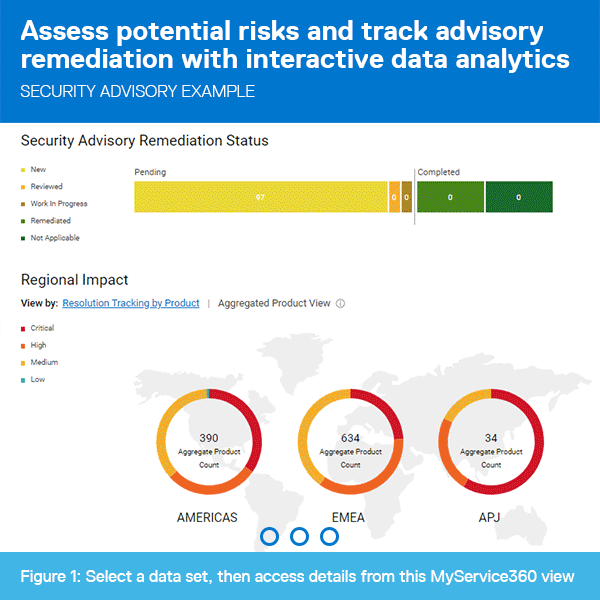In my spare time, I serve my community as a volunteer emergency medical technician (EMT). While uniquely fulfilling, it also presents several challenges as I have to respond and adapt to whatever type of case comes my way. Becoming an EMT was not only a natural fit for me, but it embodies what energizes me at Dell Technologies as an advocate and trainer for product and application security best practices.

Professionally, I deal with very different challenges to those of a volunteer EMT who helps people one incident at a time. At work, I educate others to correctly assess multiple, complex inputs in order to formulate appropriate responses. As a security champion, I foster a culture of security and increase secure development knowledge amongst global software teams to reach our goals. I am always looking to what more large companies can potentially do to help protect their own enterprise customers at scale.
MyService360 Insights Help You Proactively Manage Services Risks
I first encountered MyService360 as a security expert on a joint project. As I learned more about this online data analytics dashboard for enterprise hardware services and support, I knew MyService360 was a tangible and successful step towards this goal. In a nutshell, it helps companies streamline daily operational risk management for services to avoid unplanned downtime. Using interactive data visualizations, key performance indicators and robust self-service in MyService360, our customers can quickly spot potential risks, drill into data – from support cases to contracts to connectivity – and proactively manage activity to maintain services health. And once storage, data protection and converged systems are connected, automated proactive support and analytics-based recommendations help them work smarter, not harder.
But we also know our customers want more. A Forrester report commissioned by Dell Technologies found 81% of IT decision makers agree automated support tools and technologies from IT service providers free up IT staff time. In addition, up to 85% plan to increase investment in data-driven support tools and technologies.
MyService360 Enhancements Now Extend Its Risk Mitigation Features
Another way Dell already makes a difference is by alerting customers of and addressing vulnerabilities in products. This is not only integral to being a trusted IT partner, but it’s an expected industry practice to inform customers they have to take steps to protect themselves and mitigate vulnerabilities. I’ve noted practices defined by the ISO 24197 standard drive a steady increase in advisory releases by IT vendors. Even though this is beneficial, our customers face an uphill task to evaluate and respond to new risks for their global environments while coordinating normal IT operations.
 Against this backdrop, I became involved in developing enhancements to the MyService360 experience for managing advisories. I am thrilled to share MyService360 now integrates advisory remediation management features that put the right details and remedies for Dell EMC systems at your fingertips, speeding risk evaluation and enabling remediation tracking at scale.
Against this backdrop, I became involved in developing enhancements to the MyService360 experience for managing advisories. I am thrilled to share MyService360 now integrates advisory remediation management features that put the right details and remedies for Dell EMC systems at your fingertips, speeding risk evaluation and enabling remediation tracking at scale.
Taking a Closer Look
Let’s use Dell Security Advisories as our example. Security advisories are published articles that bring security vulnerabilities related to Dell and Dell EMC products to our customer’s attention so they understand the risk. The customer then decides whether to take the necessary steps to address that product’s exposure in their environment.
Multiply this best practice across multiple IT suppliers and you can quickly see the challenges it poses for customers and support teams. Today, teams sift through hundreds of advisories to decipher which ones may or may not impact their global install base. For many, there is the grind of manually pulling data from emails and other sources into spreadsheets – a time-consuming process that can further delay action. For those impacted, tracking progress toward remediation is not a one-step process, particularly if multiple Dell EMC products have been installed.
This scene plays out in much the same way for technical advisories.
The Solution – Centralize Advisory Management Online
Considering the level of effort required to manage advisories today, our redesigned MyService360 experience creates the foundation for simplifying this process. The intuitive, streamlined dashboard provides you with interactive data visualizations and remediation workflow features for both technical and security advisories.
For the specific products and locations you manage, you can gain:
- A personalized view of advisories which may impact your environment, broken down by geography and site
- Ability to manage advisories based on relevance
- Ability to identify and manage all products affected by one advisory from a single view
- A comprehensive summary of detailed information and guided actions
- A single source of truth for risk remediation tracking and auditing – at a company, site or asset level
With the help of MyService360, you now not only have greater transparency to the status of your remediation progress, but also a faster answer to the question: Does this advisory pose a risk to our environment, and, if so, what are we doing about it?
Check it out for yourself and take a great step toward easier risk mitigation.



